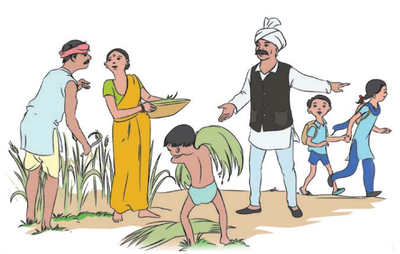Child Labour
Child Labour
Introduction
Child labour refers to the employment of children in any work that deprives them of their childhood, interferes with their ability to attend regular school, and that is mentally, physically, socially or morally dangerous and harmful. In villages, it is a common sight to see children of poor families working in fields or elsewhere to contribute to the family income. Such children are deprived of opportunities of education and are also prone to health risks.
In a sense, child labour is open exploitation as it deprives children of education and pushes them into exploitative situations. The side-effects of working at a young age are: risks of contracting occupational diseases like skin diseases, diseases of the lungs, weak eyesight, TB etc.; vulnerability to sexual exploitation at the workplace; deprived of education. They grow up unable to avail development opportunities and end up as unskilled workers for the rest of their lives.

It has been observed that in villages especially, representatives of various industries lure children with promises of jobs and wealth and bring them to the city where they are employed as bonded labour in factories. Many children are also employed as household help where they are paid minimum wages and are made to do maximum physical work.
What the law says about child labour
According to Article 23 of the Indian Constitution any type of forced labour is prohibited. Article 24 states that a child under 14 years cannot be employed to perform any hazardous work. Similarly, Article 39 states that “the health and strength of workers, men and women, and the tender age of children are not abused”. In the same manner, Child Labour Act (Prohibition and Regulation) 1986 prohibits children under the age of 14 years to be working in hazardous industries and processes. Child Labour (Prohibition & Regulation) Amendment Act 2016 prohibits the employment of Children below 14 years in all employment and with the provisions for prohibition on employment of adolescents (14-18 Years) in the scheduled hazardous occupations and processes.
Role of panchayat members in mitigating child labour
- Generate awareness about the ill-effects of child labour,
- Encourage parents to send their children to school
- Create an environment where children stop working and get enrolled in schools instead
- Ensure that children have sufficient facilities available in schools
- Inform industry owners about the laws prohibiting child labour and the penalties for violating these laws
- Activate Balwadis and Aanganwadis in the village so that working mothers do not leave the responsibility of younger children on their older siblings
- Motivate Village Education Committees (VECs) to improve the conditions of schools.
Source : NCPCR handbook on Safe Childhood Programme for Panchayat members
Last Modified : 7/1/2024
This topic provides information about the world da...
The topic covers about various policies related to...
this page contains Child Rights and Advocacy Resou...
A simple explainer providing a snapshot of the law...
